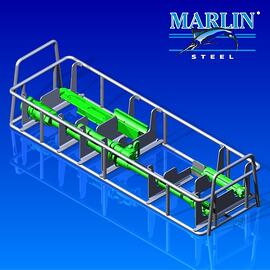Marlin Steel: Experts in Custom Ultrasonic Cleaning Baskets
When you partner with Marlin Steel for designing and manufacturing custom ultrasonic baskets, you'll benefit from the following:
- Engineering expertise. Our team of professional engineers has extensive practical experience designing custom, tight-tolerance wire forms like our ultrasonic cleaning baskets to meet the parts-washing needs of our diverse client base.
- Design and prototyping capabilities. We utilize tools like computer modeling technology as well as Finite Element Analysis (FEA) and virtual stress tests to confirm that your baskets are designed for maximum functionality and performance. Our team will work closely with you to develop your perfect custom ultrasonic cleaning baskets, with quick turnaround on prototypes.
- High-quality material and coating selections. Marlin Steel offers a selection of quality materials, such as grades 304 and 316 stainless steel, as well as coatings of nylon, PVC, Teflon®, and more. Based on your specific needs and processes, we'll help you find the ideal options for baskets that resist, for example, the high heat and harsh chemical cleaning agents involved in parts-washing operations.
- Comprehensive basket features. Our ultrasonic cleaning baskets feature:
- Acid-resistant construction
- Dividers and wire inserts
- Heavy-duty/large parts cleaning solutions
- No-scratch surfaces
- Robotic handling compatibility
- Stackable designs for increased capacity and space optimization
- High-capacity options
- State-of-the-art manufacturing. We integrate automation and robotic technologies in processes like welding to simultaneously support efficiency and optimal quality control in our operations.
- Quality assurance (QA). Our company is an ISO 9001:2015 and ISO 13485:2016-certified business. With our "Quality Engineered Quick®" philosophy, Marlin Steel is committed to the timely delivery of cost-effective parts-cleaning baskets without ever sacrificing quality. Our mechanical engineers, who make up 25% of our team, follow a comprehensive QA checklist to ensure full customer satisfaction and products that meet the highest standards for quality.
- 100% Made-in-America. For maximum quality control, Marlin Steel's products are also guaranteed to be made in the USA.





















.jpg?width=270&name=00045001%20(1).jpg)





























